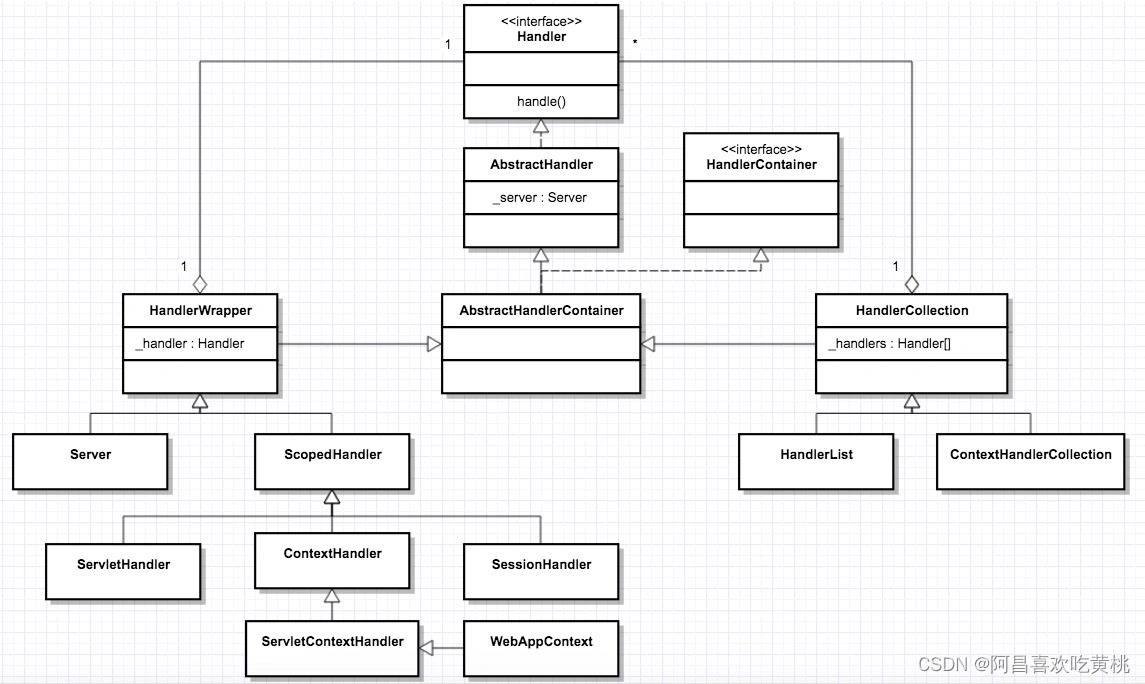Day696.Jetty如何实现具有上下文信息的责任链 -深入拆解 Tomcat & Jetty
Posted 阿昌喜欢吃黄桃
tags:
篇首语:本文由小常识网(cha138.com)小编为大家整理,主要介绍了Day696.Jetty如何实现具有上下文信息的责任链 -深入拆解 Tomcat & Jetty相关的知识,希望对你有一定的参考价值。
Jetty如何实现具有上下文信息的责任链
Hi,阿昌来也,今天学习记录的内容是关于Jetty如何实现具有上下文信息的责任链。
Tomcat 和 Jetty 的核心功能是处理请求,并且请求的处理者不止一个,因此 Tomcat 和 Jetty 都实现了责任链模式,其中 Tomcat 是通过 Pipeline-Valve 来实现的,而 Jetty 是通过 HandlerWrapper 来实现的。
HandlerWrapper 中保存了下一个 Handler 的引用,将各 Handler 组成一个链表,像下面这样:
WebAppContext -> SessionHandler -> SecurityHandler -> ServletHandler
这样链中的 Handler 从头到尾能被依次调用,除此之外,Jetty 还实现了“回溯”的链式调用,那就是从头到尾依次链式调用 Handler 的方法 A,完成后再回到头节点,再进行一次链式调用,只不过这一次调用另一个方法 B。
一次链式调用不就够了吗,为什么还要回过头再调一次呢?这是因为一次请求到达时,Jetty 需要先调用各 Handler 的初始化方法,之后再调用各 Handler 的请求处理方法,并且初始化必须在请求处理之前完成。
而 Jetty 是通过 ScopedHandler 来做到这一点的,那 ScopedHandler 跟 HandlerWrapper 有什么关系呢?
ScopedHandler 是 HandlerWrapper 的子类,各种 Handler 的继承关系:

从图上我们看到,ScopedHandler 是 Jetty 非常核心的一个 Handler,跟 Servlet 规范相关的 Handler,比如 ContextHandler、SessionHandler、ServletHandler、WebappContext 等都直接或间接地继承了 ScopedHandler。
一、HandlerWrapper
HandlerWrapper 的源码:
public class HandlerWrapper extends AbstractHandlerContainer
protected Handler _handler;
@Override
public void handle(String target,
Request baseRequest,
HttpServletRequest request,
HttpServletResponse response)
throws IOException, ServletException
Handler handler=_handler;
if (handler!=null)
handler.handle(target,baseRequest, request, response);
从代码可以看到它持有下一个 Handler 的引用,并且会在 handle 方法里调用下一个 Handler。
二、ScopedHandler
ScopedHandler 的父类是 HandlerWrapper,ScopedHandler 重写了 handle 方法,在 HandlerWrapper 的 handle 方法的基础上引入了 doScope 方法。
public final void handle(String target,
Request baseRequest,
HttpServletRequest request,
HttpServletResponse response)
throws IOException, ServletException
if (isStarted())
if (_outerScope==null)
doScope(target,baseRequest,request, response);
else
doHandle(target,baseRequest,request, response);
上面的代码中是根据_outerScope是否为 null 来判断是使用 doScope 还是 doHandle 方法。
那_outScope又是什么呢?
_outScope是 ScopedHandler 引入的一个辅助变量,此外还有一个_nextScope变量。
protected ScopedHandler _outerScope;
protected ScopedHandler _nextScope;
private static final ThreadLocal<ScopedHandler> __outerScope= new ThreadLocal<ScopedHandler>();
我们看到__outerScope是一个 ThreadLocal 变量,ThreadLocal 表示线程的私有数据,跟特定线程绑定。
需要注意的是__outerScope实际上保存了一个 ScopedHandler。
ScopedHandler 继承自 HandlerWrapper,所以也是可以形成 Handler 链的,Jetty 的源码注释中给出了下面这样一个例子:
ScopedHandler scopedA;
ScopedHandler scopedB;
HandlerWrapper wrapperX;
ScopedHandler scopedC;
scopedA.setHandler(scopedB);
scopedB.setHandler(wrapperX);
wrapperX.setHandler(scopedC)
经过上面的设置之后,形成的 Handler 链是这样的:

上面的过程只是设置了_handler变量,那_outScope和_nextScope需要设置成什么样呢?
为了方便你理解,我们先来看最后的效果图:

从上图我们看到:
scopedA 的_nextScope=scopedB,scopedB 的_nextScope=scopedC,为什么 scopedB 的_nextScope不是 WrapperX 呢,因为 WrapperX 不是一个 ScopedHandler。scopedC 的_nextScope是 null(因为它是链尾,没有下一个节点)。
因此我们得出一个结论:_nextScope指向下一个 Scoped 节点的引用,由于 WrapperX 不是 Scoped 节点,它没有_outScope和_nextScope变量。
注意到 scopedA 的_outerScope是 null,scopedB 和 scopedC 的_outScope都是指向 scopedA,即_outScope指向的是当前 Handler 链的头节点,头节点本身_outScope为 null。
弄清楚了_outScope和_nextScope的含义,下一个问题就是对于一个 ScopedHandler 对象如何设置这两个值以及在何时设置这两个值。
答案是在组件启动的时候,下面是 ScopedHandler 中的 doStart 方法源码:
@Override
protected void doStart() throws Exception
try
//请注意_outScope是一个实例变量,而__outerScope是一个全局变量。先读取全局的线程私有变量__outerScope到_outerScope中
_outerScope=__outerScope.get();
//如果全局的__outerScope还没有被赋值,说明执行doStart方法的是头节点
if (_outerScope==null)
//handler链的头节点将自己的引用填充到__outerScope
__outerScope.set(this);
//调用父类HandlerWrapper的doStart方法
super.doStart();
//各Handler将自己的_nextScope指向下一个ScopedHandler
_nextScope= getChildHandlerByClass(ScopedHandler.class);
finally
if (_outerScope==null)
__outerScope.set(null);
为什么要设计这样一个全局的__outerScope,这是因为这个变量不能通过方法参数在 Handler 链中进行传递,但是在形成链的过程中又需要用到它。
当 scopedA 调用 start 方法时,会把自己填充到__scopeHandler中,接着 scopedA 调用super.doStart。
由于 scopedA 是一个 HandlerWrapper 类型,并且它持有的_handler引用指向的是 scopedB,所以super.doStart实际上会调用 scopedB 的 start 方法。
这个方法里同样会执行 scopedB 的 doStart 方法,不过这次__outerScope.get方法返回的不是 null 而是 scopedA 的引用,所以 scopedB 的_outScope被设置为 scopedA。
接着super.dostart会进入到 scopedC,也会将 scopedC 的_outScope指向 scopedA。
到了 scopedC 执行 doStart 方法时,它的_handler属性为 null(因为它是 Handler 链的最后一个),所以它的super.doStart会直接返回。
接着继续执行 scopedC 的 doStart 方法的下一行代码:
_nextScope=(ScopedHandler)getChildHandlerByClass(ScopedHandler.class)
对于 HandlerWrapper 来说 getChildHandlerByClass 返回的就是其包装的_handler对象,这里返回的就是 null。
所以 scopedC 的_nextScope为 null,这段方法结束返回后继续执行 scopedB 中的 doStart 中,同样执行这句代码:
_nextScope=(ScopedHandler)getChildHandlerByClass(ScopedHandler.class)
因为 scopedB 的_handler引用指向的是 scopedC,所以 getChildHandlerByClass 返回的结果就是 scopedC 的引用,即 scopedB 的_nextScope指向 scopedC。
同理 scopedA 的_nextScope会指向 scopedB。scopedA 的 doStart 方法返回之后,其_outScope为 null。
请注意执行到这里只有 scopedA 的_outScope为 null,所以 doStart 中 finally 部分的逻辑被触发,这个线程的 ThreadLocal 变量又被设置为 null。
finally
if (_outerScope==null)
__outerScope.set(null);
_outScope和_nextScope的值到底有什么用?
如果你觉得上面的过程比较复杂,可以跳过这个过程,直接通过上面的图来理解_outScope和_nextScope的值,而这样设置的目的是用来控制 doScope 方法和 doHandle 方法的调用顺序。
实际上在 ScopedHandler 中对于 doScope 和 doHandle 方法是没有具体实现的,但是提供了 nextHandle 和 nextScope 两个方法,下面是它们的源码:
public void doScope(String target,
Request baseRequest,
HttpServletRequest request,
HttpServletResponse response)
throws IOException, ServletException
nextScope(target,baseRequest,request,response);
public final void nextScope(String target,
Request baseRequest,
HttpServletRequest request,
HttpServletResponse response)
throws IOException, ServletException
if (_nextScope!=null)
_nextScope.doScope(target,baseRequest,request, response);
else if (_outerScope!=null)
_outerScope.doHandle(target,baseRequest,request, response);
else
doHandle(target,baseRequest,request, response);
public abstract void doHandle(String target,
Request baseRequest,
HttpServletRequest request,
HttpServletResponse response)
throws IOException, ServletException;
public final void nextHandle(String target,
final Request baseRequest,
HttpServletRequest request,
HttpServletResponse response)
throws IOException, ServletException
if (_nextScope!=null && _nextScope==_handler)
_nextScope.doHandle(target,baseRequest,request, response);
else if (_handler!=null)
super.handle(target,baseRequest,request,response);
从 nextHandle 和 nextScope 方法大致上可以猜到 doScope 和 doHandle 的调用流程。
通过一个调用栈来理解:
A.handle(...)
A.doScope(...)
B.doScope(...)
C.doScope(...)
A.doHandle(...)
B.doHandle(...)
X.handle(...)
C.handle(...)
C.doHandle(...)
因此通过设置_outScope和_nextScope的值,并且在代码中判断这些值并采取相应的动作,目的就是让 ScopedHandler 链上的 doScope 方法在 doHandle、handle 方法之前执行。
并且不同 ScopedHandler 的 doScope 都是按照它在链上的先后顺序执行的,doHandle 和 handle 方法也是如此。
这样 ScopedHandler 帮我们把调用框架搭好了,它的子类只需要实现 doScope 和 doHandle 方法。
比如在 doScope 方法里做一些初始化工作,在 doHanlde 方法处理请求。
三、ContextHandler
接下来我们来看看 ScopedHandler 的子类 ContextHandler 是如何实现 doScope 和 doHandle 方法的。
ContextHandler 可以理解为 Tomcat 中的 Context 组件,对应一个 Web 应用,它的功能是给 Servlet 的执行维护一个上下文环境,并且将请求转发到相应的 Servlet。
那什么是 Servlet 执行的上下文?我们通过 ContextHandler 的构造函数来了解一下:
private ContextHandler(Context context, HandlerContainer parent, String contextPath)
//_scontext就是Servlet规范中的ServletContext
_scontext = context == null?new Context():context;
//Web应用的初始化参数
_initParams = new HashMap<String, String>();
...
我们看到 ContextHandler 维护了 ServletContext 和 Web 应用的初始化参数。
那 ContextHandler 的 doScope 方法做了些什么呢?
它的关键代码:
public void doScope(String target, Request baseRequest, HttpServletRequest request, HttpServletResponse response) throws IOException, ServletException
...
//1.修正请求的URL,去掉多余的'/',或者加上'/'
if (_compactPath)
target = URIUtil.compactPath(target);
if (!checkContext(target,baseRequest,response))
return;
if (target.length() > _contextPath.length())
if (_contextPath.length() > 1)
target = target.substring(_contextPath.length());
pathInfo = target;
else if (_contextPath.length() == 1)
target = URIUtil.SLASH;
pathInfo = URIUtil.SLASH;
else
target = URIUtil.SLASH;
pathInfo = null;
//2.设置当前Web应用的类加载器
if (_classLoader != null)
current_thread = Thread.currentThread();
old_classloader = current_thread.getContextClassLoader();
current_thread.setContextClassLoader(_classLoader);
//3. 调用nextScope
nextScope(target,baseRequest,request,response);
...
从代码我们看到在 doScope 方法里主要是做了一些请求的修正、类加载器的设置,并调用 nextScope,请你注意 nextScope 调用是由父类 ScopedHandler 实现的。
接着我们来 ContextHandler 的 doHandle 方法:
public void doHandle(String target, Request baseRequest, HttpServletRequest request, HttpServletResponse response) throws IOException, ServletException
final DispatcherType dispatch = baseRequest.getDispatcherType();
final boolean new_context = baseRequest.takeNewContext();
try
//请求的初始化工作,主要是为请求添加ServletRequestAttributeListener监听器,并将"开始处理一个新请求"这个事件通知ServletRequestListener
if (new_context)
requestInitialized(baseRequest,request);
...
//继续调用下一个Handler,下一个Handler可能是ServletHandler、SessionHandler ...
nextHandle(target,baseRequest,request,response);
finally
//同样一个Servlet请求处理完毕,也要通知相应的监听器
if (new_context)
requestDestroyed(baseRequest,request);
从上面的代码我们看到 ContextHandler 在 doHandle 方法里分别完成了相应的请求处理工作。
五、总结
Jetty 中 ScopedHandler 的实现原理,剖析了如何实现链式调用的“回溯”。
主要是确定了 doScope 和 doHandle 的调用顺序,doScope 依次调用完以后,再依次调用 doHandle,它的子类比如 ContextHandler 只需要实现 doScope 和 doHandle 方法,而不需要关心它们被调用的顺序。
这背后的原理是,ScopedHandler 通过递归的方式来设置_outScope和_nextScope两个变量,然后通过判断这些值来控制调用的顺序。
递归是计算机编程的一个重要的概念,在各种面试题中也经常出现,如果你能读懂 Jetty 中的这部分代码,毫无疑问你已经掌握了递归的精髓。
另外我们进行层层递归调用中需要用到一些变量,比如 ScopedHandler 中的__outerScope,它保存了 Handler 链中的头节点,但是它不是递归方法的参数,那参数怎么传递过去呢?
一种可能的办法是设置一个全局变量,各 Handler 都能访问到这个变量。但这样会有线程安全的问题,因此 ScopedHandler 通过线程私有数据 ThreadLocal 来保存变量,这样既达到了传递变量的目的,又没有线程安全的问题。
ScopedHandler 的 doStart 方法,最后一步是将线程私有变量__outerScope设置成 null,为什么需要这样做呢?
为了下次请求复用,可以重新处理下一次请求。
因为线程是用池化技术,下次请求优先共用线程,而不是新建线程,每一次请求的请求链互不影响。
以上是关于Day696.Jetty如何实现具有上下文信息的责任链 -深入拆解 Tomcat & Jetty的主要内容,如果未能解决你的问题,请参考以下文章